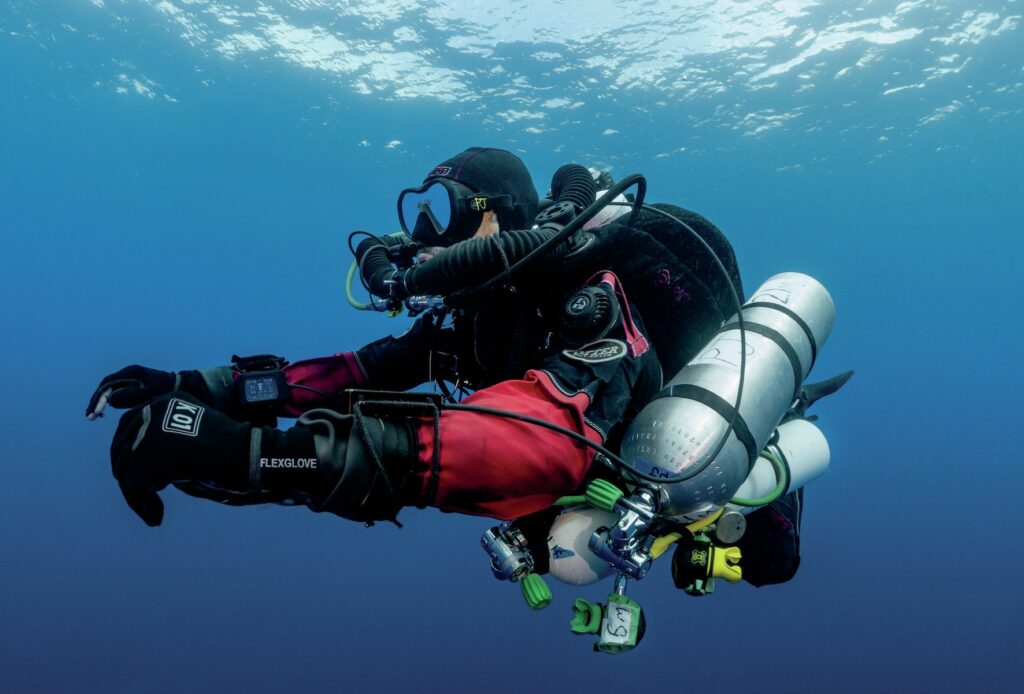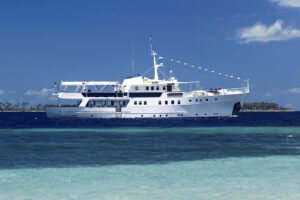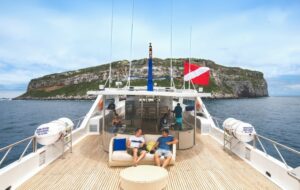PJ Prinsloo is a highly experienced technical diver and explorer, and RAID International’s Vice President, Training. Here he chats about how he got started, the challenges of writing dive courses, and what draws him in search of the elusive coelacanth.
How did you first get into scuba diving?
A: Probably not how most people start recreational scuba diving! I started as a commercial diver after school and when I couldn’t renew my work permit for Namibia 25 years ago, I became a recreational scuba instructor.
What led you down the technical route?
A: Having spent several years teaching entry-level divers and running dive stores in South Africa, I missed the challenges from commercial diving and wanted to develop my own personal skill level. I was already starting to do some underwater research work and realized that I needed to be more self-reliant and better equipped to spend longer periods of time underwater. I also had a yearning to see things that no one has seen before, and technical diving gives you the necessary skills to do that.

You worked as a commercial diver in the cold waters of South Africa’s western coast. How did you get involved in this line of work in the first place?
A: I had never dived before, well I had done a bit of freediving but had never even thought of scuba diving as a sport, let alone as a working diver. Like many youngsters I was clueless about what I wanted to do after school. I laboured through a month behind a desk but was seriously unhappy. A friend at the time owned a commercial diamond diving operation in Namibia and he offered me a job – I accepted without a moment’s hesitation.
The next day I gave 24 hour notice and resigned. A couple of weeks later I had moved to Cape Town and was on a commercial diver’s course. I’ve had a couple of breaks from the industry every now and then, but essentially diving has been a part of my life ever since.

You are now Vice President for Diver Training for RAID International, but you have been working closely with the international office on various courses for some time, including the Liberty CCR courses for both backmount and sidemount units and the Performance Diver course. What are the main challenges with writing certification courses?
A: Thank you, I am excited about my role and hope I can make positive impact to diver training worldwide. Firstly, I think it is creating a programme that is meaningful. Once a student has completed a course, I want them to walk away feeling like they have learned something and become a better diver. The course needs to be enjoyable both from an academic point of view and in skill development, at the same time ensuring that it is within standards set by the various organizations that govern scuba standards. I love that our team at RAID are willing to stick their necks out occasionally and challenge the way things have been done in this industry. I hope we never stop innovating and disrupting.

You have been actively involved in several major expeditions in South Africa, Egypt and Malta – what have been some of the most interesting?
A: Thinking back over the last 15 or so years I have been involved in some amazing projects and met so many great people. I have also had some very close calls, especially in the early days when we started doing some research projects with no one to guide us from a safety perspective. I remember some very intimate encounters working with sharks – they are definitely more curious of you when you are diving with a CCR.
But I have to say, it’s the most-recent project that has me absolutely hooked. Initially I thought I was just going to have a look at some old pottery, but nothing prepared me for how breath-taking it would be going to 110m and seeing 2,700-year-old amphora. Since 2019 I’ve been working with an exceptionally talented team headed by Timmy Gambin of the Malta University, excavating the Phoenician shipwreck.
You’re down there excavating, and you come across something that you know has not been seen by another human being in almost 3,000 years – you can’t help but feel a little overwhelmed. The history and the story just has me fascinated.
You have also made several deep dives off the east coast of South Africa in search of the elusive coelacanth. What is it about these prehistoric fish that draws you to look for them?
A: To be honest, it’s not a particularly good-looking fish and docile, just bimbling about the bottom of the ocean. But the fact is, very few people in the world have seen a live specimen nor will they ever get the opportunity to.
As far as science is concerned it shouldn’t exist, but for whatever reason, this dinosaur fish has survived millions of years. We know nothing about this animal, so there are some unanswered questions, maybe we can help find the answers. Nothing motivates me more than being the first, or among the first, to set my eyes on something unique.

In March 2020, you were made a member of The Explorers Club. What did it mean to be made a part of such a prestigious group?
A: I’m fortunate to have an amazing group of friends in the Club who were on my case from around 2018 to apply. I relented in 2020 and was thrilled when I was accepted. Just reading the letters of motivation from my sponsors was enough to humble me and realize how grateful I am to be among some of the greatest adventurers and explorers the world has seen. Almost two years later, and it still doesn’t feel real. I haven’t been to club headquarters yet due to travel restrictions, but I can’t wait to visit soon.
As we always ask in these Q&As, what is your mostmemorable moment in diving?
A: This would have to be one of the most-difficult questions to answer. Over 25 years and thousands of dives, almost all of which have produced some epic memories. Divers are very privileged to experience true wild nature closer than most people. Living in South Africa we get to do a lot of safaris in the many nature reserves dotted around the country and as amazing as it is to see animals in the wild, you’re usually in a vehicle, viewing the wildlife from a distance. Divers get to be right in centre of the action.
Despite all the wonders we get to see, I think it is also the fact that we get to share those experiences with our buddies underwater. The most-fond memory I have is one of the dives my wife and I did on Ras Mohamed in the Red Sea. It was just one of the dives that was action packed with absolutely perfect conditions. The water was crystal clear, deep azure blue with the sun right above us.
The masses of fish life we saw on the dive were strikingly colourful thanks to the bright sunlight. The highlight was at the end of the dive when we were simultaneously climbing the ladder back onto the liveaboard, and we looked at each other, I will never forget that smile across her face almost pushing her mask off. Sharing those memories is what makes diving special.

On the flipside, what is your worst diving memory?
A: I’m thankful that I’ve had very few bad experiences diving, especially given the number of deep technical dives I’ve done that are burdened with more risk. One of the most stressful dives I can recall was a deep cave dive with a friend and two people I had never dived with before. Not my ideal scenario. Everything was going well, we were having a great dive. I was diver number one and my friend was number two going into the cave.
We had gone through a tight restriction and approaching a second restriction and, being close to my turn-pressure, I decided that was far enough and decided to turn the dive and head out. By that stage we had also racked up a fair amount of deco. As we had turned around, I was now at the back of the group exiting the cave. About ten metres from the restriction I saw some rapid light movements, seconds later there was a complete silt out and I couldn’t see anything. I dropped down immediately and was happy to find the line just to the left of me.
Reaching the restriction, I could see someone was stuck, but what worried me most was that it was not my buddy who should have been in front of me. I had just swum all along the line and should have come across him. I was starting to formulate a plan to get us out of the situation when my buddy’s hand gently grabbed hold of my arm and I could see that the diver ahead was now free of the restriction and moving forward.
The diver had gotten some loose line snagged on a rock and my buddy had been next to him trying to cut the line and get him free. The whole ordeal only lasted a minute or two, but it highlights how in any emergency you just need to keep your stress level in check.

So what does the future hold for PJ Prinsloo and RAID?
A: It has been such a great and rewarding experience working with the RAID team the last few years. I’m excited about what is ahead. It seems every year we attract some incredible instructors and dive centres, the team is continually growing and getting stronger. I feel strongly that too many things have stagnated in the scuba industry, and that some things are being done a particular way because that’s how it’s always been done.
RAID may not be the biggest training agency in the world, but we certainly are the most innovative. It’s really rewarding as you watch many agencies adopt some of the practices that were implemented in our system. It’s refreshing to see us being disruptive in the market and I hope that as the head of training, I can continue to challenge the norm and make diving safer. We have some exciting things up our sleeves that will certainly help grow ‘brand scuba’ so that everyone can benefit.
This article was originally published in Scuba Diver UK #67.
Subscribe digitally and read more great stories like this from anywhere in the world in a mobile-friendly format. Link to the article








